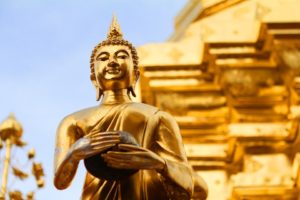Buddhism is one of the world’s great religions and is practiced by millions around the world. It was founded by the man known as Siddhartha Gautama, later called the Buddha (meaning the Enlightened One). It is sometimes known as the Middle Way because the Buddha taught that the path between the extremes of life is the best way to live in order to work toward achieving Enlightenment.
Siddhartha was born a prince and early in his life experienced all the riches and pleasures that the palace life could offer. Later he renounced these pleasures and went to the opposite extreme of denial, suffering, and sacrifice. When this did not lead to enlightenment, the Buddha forsook the path of denial, ate some food, sat under the Bodhi tree and, according to Buddhist teachings, achieved enlightenment.

Over the next 40 years, Shakyamuni Buddha taught the Middle Way as the correct path of life, traveling between pleasure and pain, happiness and sorrow. The Buddha began by espousing the Four Noble Truths: the truth of suffering, the truth of the cause of suffering, the truth that suffering can end and the true method for removal of suffering. He said that all living beings experience suffering sometime during their lives, even the richest and most cossetted princes. He taught that suffering is caused by desire and ignorance. We suffer because we crave what we cannot have or we suffer because we get too much of a good thing or we suffer because of ignorant actions that create Karma (the spiritual equivalent of the law of action and reaction where negative acts generate more negativity).
The Third Noble Truth states that there is a way out of suffering, while the Fourth Noble Truth says that the method for ending suffering is to follow the Eightfold Path. This consists of: right views and right intentions (the foundations of wisdom); right speech, right actions and right livelihood (the foundations of ethical conduct); right effort, right mindfulness and right concentration (the foundations of mental development). When these eight principles are adhered to, the aspirant is on the Middle Way, which the Buddha teaches will lead ultimately to the end of suffering.
Another way to understand the Middle Way is to examine Buddhism’s five precepts.
The eightfold path describes the correct actions, while the five precepts define what actions should be avoided in order to maintain one’s spiritual journey. The five precepts are: Do not kill, Do not steal, do not engage in sexual misconduct and sensual overindulgence (e.g., overeating), do not lie and do not get intoxicated (which causes the loss of mindfulness). If one follows these precepts, one stays on the Middle Way.
There are several forms of Buddhism. The two main schools are Theravada and Mahayana. In Theravada teachings (sometimes known as the lesser vehicle), the goal is to achieve one’s own enlightenment through meditation and mindfulness. The Mahayana, or greater vehicle, the goal is nothing less than the enlightenment of all beings through one’s own efforts. Each school respects the other, and in the basics, they are following the same teachings of the Buddha: the four noble truths, the eightfold path, the five precepts, and the Middle Way.





